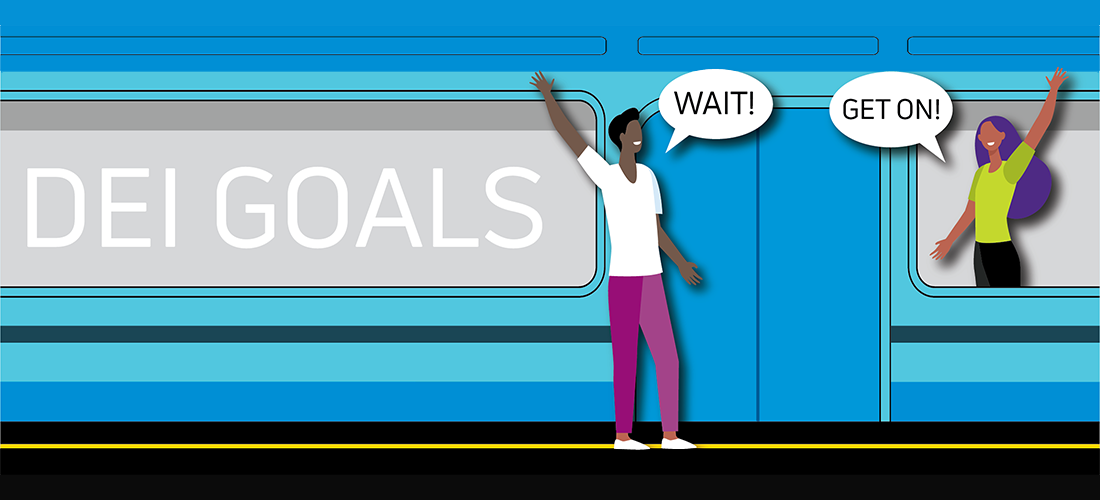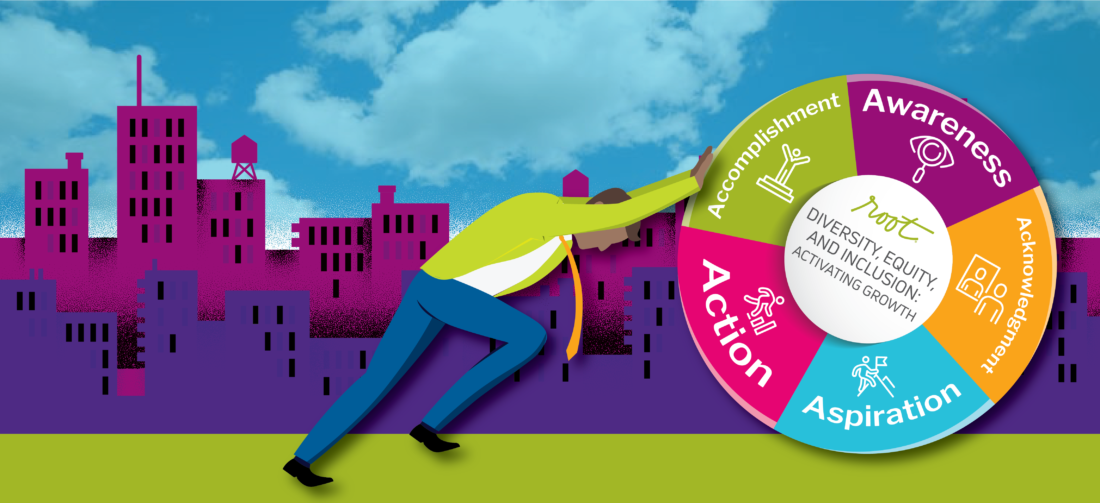Hi. Us, again. Over the past few weeks, we’ve been talking about unconscious bias training efforts, how they often lack practical frameworks, and how we can fight defensiveness and marginalization with empathetic connection.
It’s time to take a step back. Bias training can’t be “an episodic experience to solve a systemic problem.” We can’t ask people to experience training with no train. If we do, unconscious bias training efforts, for many, are just another isolated and disconnected “flavor of the month” training that “distracts from my real work.”
So how do we avoid this?
Trainings need to orient themselves within a larger story by providing opportunities to learn about and discuss organization-wide efforts and solutions. When people walk out the door, they should understand how this experience connects to larger organizational aspirations and goals.
However, it’s hard to discuss a larger story if one doesn’t exist.
Before spending tons of time and money launching a new training, leaders need to align on where this train is going and what is involved. One that is aware of the current state, has defined aspirations and measures of success, and has been formalized in an organizational strategy or roadmap. Training, done well, can be a spark for change. But sustained behavior change is the hard part. Below are four questions you need to answer before you ask people to board the train with you.
Define Reality: Where are we today?
First, do you know the current reality or does it need to be uncovered? How do you know what you know? Is it anecdotal from a pocket of leaders? Or have you done the systematic work to feel confident in the information you are using to determine the needs and mindsets of your people?
Finding out the answers to these questions is imperative to creating a smart, effective, and compelling training initiative. Without pinpointing what needs to be improved, it’s impossible to develop a program that addresses the right topics. And getting an accurate sense of where your organization is requires more than those two or three D&I questions in the annual employee engagement survey. It’s imperative to go beyond the surface and really listen to the voices of your frontline managers and employees – and not just after major societal events. Consistently seeking out employee perspectives speaks volumes to your people about the authenticity of your DEI journey and ensures that your defined solutions are relevant and needed. Without this, your efforts can quickly become viewed as performative or political.
Develop a Compelling Future State: To what are you aspiring as an organization? And why?
With a solid foundation of insight, consider how your DEI journey fits within your organizational identity, culture, and purpose. Why is DEI relevant to living your values or your business imperatives? When it comes time to execute, the rationale of “well, our competitors are doing it” will not resonate with your people, and it will certainly never generate the kind of respect and commitment you need for true behavior change. On the other hand, a narrative that paints a vision of a better, more effective organization where everyone is positioned for success will resonate both individually and collectively.
We often find that leaders don’t put forth the time and effort to align on a compelling future state for DEI. Sometimes we hear things like “we want to increase demographic representation” or “we want to better serve our diverse customer base,” but there is a lack of specificity. Other times, we see laundry lists of DEI activities, but they are disconnected from a clear destination. As leaders, invest time to crystalize your overall DEI aspiration – whether it be through the process of visualizing and preparing to engage your people, or through dedicated alignment sessions – begin to build the narrative that serves as a foundation for all other efforts. Through consistent messaging, integrated and purposeful initiatives, and a shared vision, leaders become equipped to inspire others toward sustained change.
Define and Align On Strategic Critical Priorities: Are your key leaders and stakeholders aligned on where you want to go? What are you hoping to achieve and look like three, five, or ten years from now? Is there alignment to get there?
Now you’re one step closer to execution. It’s time to get strategic. Having a desired future state is great, but do you have the alignment and the strategic priorities mapped out in a way that can get you there?
It’s critical to define success and measurable success within concrete timeframes (e.g., three-, five-, or ten-year goals). Use these time-bounded measures of success to drive urgency and engagement. In conjunction with key leaders and stakeholders, make sure you’ve defined a roadmap that let’s people know what the organizational priorities are, in what sequence, and who needs to be involved to get there. Don’t let your DEI efforts be lumped into a list of disconnected initiatives or programs. Architect them into a purposeful and powerful plan for change.
Ensure Behaviors and Culture Support the Vision: What kinds of mindset or behavioral changes do we need to see from each level or function of the organization?
How do we get this train moving with everyone on board? Having defined the range of priorities and activities needed to achieve your measurable aspirations of success, it’s time to determine what your people need to get there.
A single unconscious bias training can’t do it all. With respect to your people, it may be inclusive leadership training that is most urgent. Perhaps your front line needs a collective mindset shift by engaging them in how DEI matters for our collective success and what changes are going to get us there. Do you already have pockets of success within your organization? Learning from what is working and then scaling that across the organization ensures that everyone can move as one as they integrate DEI skills into their role.
When training is part of your culture, the impact is massive.
Whatever the solution, any or all, remember to be thinking about the kinds of changes that are needed and how you can engineer a journey that resonates with your people, shifts their mindsets, and equips them for true behavior change. Ultimately, you want to build the desire for training and learning into your organization’s culture. You want people to see opportunities for learning as a welcome and necessary part of their work experience, not a one-off disruption. When your people start viewing new information as a critical part of their development and for the progress of the business, only then are you truly moving your organization in the right direction.









